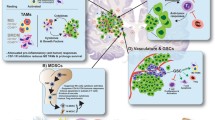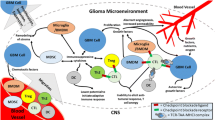Abstract
Malignant brain tumors are notoriously invasive. Although surgical debulking can relieve the patient of the main mass of tumor, adjuvant treatments are needed to target the glioma cells that infiltrate through normal parenchyma as single cells or pockets of tumor cells from which recurrent tumors arise. Successful adjuvant cellular therapy of brain tumors, or activation of endogenous immune cells, requires that either cell effectors make direct contact with tumor cells or come within close proximity to them and exert an indirect effect. This review examines current clinical trials aimed at direct lysis of glioma cells and trials making gliomas more visible to the endogenous immune system.
Similar content being viewed by others
References and Recommended Reading
Prados MD, Berger MS, Wilson CB: Primary central nervous system tumors: advances in knowledge and treatment. Ca Cancer J Clin 1998, 48:331–360.
Prados MD, Levin V: Biology and treatment of malignant glioma. Semin Oncol 2000, 27:S1-S10.
Burger PC, Schiethauer BW, Vogel SS: Surgical Pathology of the Nervous System and Its Coverings. New York: Churchill Livingston; 1991.
Giese A, Laube B, Zapf S, et al.: Glioma cell adhesion and migration on human brain sections. Anticancer Res 1998, 18:2435–2447.
Silbergeld DL, Chicoine MR: Isolation and characterization of human malignant glioma cells from histologically normal brain. J Neurosurg 1997, 86:525–531.
DeAngelis LM, Burger PC, Green SB, Cairncross JG: Malignant glioma: who benefits from adjuvant chemotherapy? Ann Neurol 1998, 44:691–695.
Pardridge WM: CNS drug design based on principles of blood-brain barrier transport. J Neurochem 1998, 70:1781–1792.
Shapiro JR, Yung WK, Shapiro WR: Isolation, karyotype, and clonal growth of heterogeneous subpopulations of human malignant gliomas. Cancer Res 1981, 41:2349–2359.
Baker DG, Krochak RJ: The response of the microvascular system to radiation: a review. Cancer Invest 1989, 7:287–294.
Gage FH: Mammalian neural stem cells. Science 2000, 287:1433–1438.
Pincus DW, Goodman RR, Fraser RA, et al.: Neural stem and progenitor cells: a strategy for gene therapy and brain repair. Neurosurgery 1998, 42:858–867.
Kruse CA, Mitchell DH, Lillehei KO, et al.: Interleukin-2-activated lymphocytes from brain tumor patients. A comparison of two preparations generated in vitro. Cancer 1989, 64:1629–1637.
Elliott L, Brooks W, Roszman T: Role of interleukin-2 (IL-2) and IL-2 receptor expression in the proliferative defect observed in mitogen-stimulated lymphocytes from patients with gliomas. J Natl Cancer Inst 1987, 78:919–922.
McVicar DW, Davis DF, Merchant RE: In vitro analysis of the proliferative potential of T cells from patients with brain tumor: glioma-associated immunosuppression unrelated to intrinsic cellular defect. J Neurosurg 1992, 76:251–260.
Liau LM, Black KL, Prins RM, et al.: Treatment of intracranial gliomas with bone marrow-derived dendritic cells pulsed with tumor antigens. J Neurosurg 1999, 90:1115–1124.
Heimberger AB, Crotty LE, Archer GE, et al.: Bone marrowderived dendritic cells pulsed with tumor homogenate induce immunity against syngeneic intracerebral glioma. J Neuroimmunol 2000, 103:16–25.
Ashley DM, Faiola B, Nair S, et al.: Bone marrow-generated dendritic cells pulsed with tumor extracts or tumor RNA induce antitumor immunity against central nervous system tumors. J Exper Med 1997, 186:1177–1182.
Wallenfriedman MA, Conrad JA, DelaBarre L, et al.: Effects of continuous localized infusion of granulocyte-macrophage colony-stimulating factor and inoculations of irradiated glioma cells on tumor regression. J Neurosurg 1999, 90:1064–1071.
Lichtor T, Glick RP, Kim TS, et al.: Prolonged survival of mice with glioma injected intracerebrally with double cytokine-secreting cells. J Neurosurg 1995, 83:1038–1044.
Sampson JH, Archer GE, Ashley DM, et al.: Subcutaneous vaccination with irradiated, cytokine-producing tumor cells stimulates CD8+ cell-mediated immunity against tumors located in the "immunologically privileged" central nervous system. Proc Natl Acad Sci U S A 1996, 93:10399–10404.
Okada H, Giezeman-Smits KM, Tahara H, et al.: Effective cytokine gene therapy against an intracranial glioma using a retrovirally transduced IL-4 plus HSVtk tumor vaccine. Gene Ther 1999, 6:219–226.
Visse E, Siesjo P, Widegren B, Sjogren HO: Regression of intracerebral rat glioma isografts by therapeutic subcutaneous immunization with interferon-gamma, interleukin-7, or B7-1-transfected tumor cells. Cancer Gene Ther 1999, 6:37–44.
Joki T, Kikuchi T, Akasaki Y, et al.: Induction of effective antitumor immunity in a mouse brain tumor model using B7-1 (CD80) and intercellular adhesive molecule 1 (ICAM-1; CD54) transfection and recombinant interleukin 12. Int J Cancer 1999, 82:714–720.
Jachimczak P, Bogdahn U, Schneider J, et al.: The effect of transforming growth factor-beta 2-specific phosphorothioate-anti-sense oligodeoxynucleotides in reversing cellular immunosuppression in malignant glioma. J Neurosurg 1993, 78:944–951.
Fakhrai H, Dorigo O, Shawler DL, et al.: Eradication of established intracranial rat gliomas by transforming growth factor beta antisense gene therapy. Proc Natl Acad Sci U S A 1996, 93:2909–2914.
Fakhrai H, Mantil J, Gramatikova S, et al.: Gene therapy of human gliomas with TGF-b2 antisense gene modified autologous tumor cells. A Phase I Clinical Trial. Proc Am Assoc Cancer Res 2000, 41:543.
DiMeco F, Rhines LD, Hanes J, et al.: Paracrine delivery of IL-12 against intracranial 9L gliosarcoma in rats. J Neurosurg 2000, 92:419–427.
Herrlinger U, Kramm CM, Johnston KM, et al.: Vaccination for experimental gliomas using GM-CSF-transduced glioma cells. Cancer Gene Ther 1997, 4:345–352.
Yu JS, Burwick JA, Dranoff G, Breakefield XO: Gene therapy for metastatic brain tumors by vaccination with granulocytemacrophage colony-stimulating factor-transduced tumor cells. Hum Gene Ther 1997, 8:1065–1072.
Graf MR, Jadus MR, Hiserodt JC, et al.: Development of systemic immunity to glioblastoma multiforme using tumor cells genetically engineered to express the membraneassociated isoform of macrophage colony-stimulating factor. J Immunol 1999, 163:5544–5551.
Okada H, Pollack IF, Lotze MT, et al.: Gene therapy of malignant gliomas: a phase I study of IL-4-HSV-TK genemodified autologous tumor to elicit an immune response. Hum Gene Ther 2000, 11:637–653.
Kruse CA, Lamb C, Hogan S, et al.: Purified herpes simplex thymidine kinase retroviral particles. II. Influence of clinical parameters and bystander killing mechanisms. Cancer Gene Ther 2000, 7:118–127.
Kruse CA, Emmett M, Savelieva E, et al.: Gene therapy of rat brain tumors with purified HSV-TK Retrovector. Efficacy studies, bystander killing and immune response. Proc Am Assoc Cancer Res 1997, 38:380.
Rosenberg SA, Lotze MT, Muul LM, et al.: A progress report on the treatment of 157 patients with advanced cancer using lymphokine-activated killer cells and interleukin-2 or highdose interleukin-2 alone. N Engl J Med 1987, 316:889–897.
Kruse CA, Merchant RE: Cellular therapy of brain tumors: Clinical trials. In Advances in Neuro-Oncology II. Edited by Kornblith PL, Walker MD. Armonk: Futura Publishing; 1997:487–504.
Hayes RL, Koslow M, Hiesiger EM, et al.: Improved long term survival after intracavitary interleukin-2 and lymphokineactivated killer cells for adults with recurrent malignant glioma. Cancer 1995, 76:840–852.
Tsurushima H, Liu SQ, Tuboi K, et al.: Reduction of end-stage malignant glioma by injection with autologous cytotoxic T lymphocytes. Jpn J Cancer Res 1999, 90:536–545. This paper demonstrates the safety and feasibility of using autologous cytotoxic T lymphocytes, activated and expanded ex vivo, then reinjected intratumorally to treat brain tumors.
Quattrocchi KB, Miller CH, Cush S, et al.: Pilot study of local autologous tumor infiltrating lymphocytes for the treatment of recurrent malignant gliomas. J Neurooncol 1999, 45:141–157. This paper details the first use of ex vivo activated and expanded T-infiltrating lymphocytes for the treatment of brain tumors. Three of six patients treated were long-term survivors.
Lillehei KO, Mitchell DH, Johnson SD, et al.: Long-term follow-up of patients with recurrent malignant gliomas treated with adjuvant adoptive immunotherapy. Neurosurgery 1991, 28:16–23.
Kruse CA, Visonneau S, Kleinschmidt-DeMasters BK, et al.: A human leukemic T cell line, TALL-104, is cytotoxic to human malignant brain tumors and traffics through brain tissue: implications for local adoptive immunotherapy. Cancer Res 2000, 60:5731–5739.
Winston KR, Freeman J, Foreman N, et al.: Intrathecal alloreactive cytotoxic T lymphocytes and interleukin-2 for recurrent ependymoma - a phase I study: Proc Am Assoc Neurol Surg/CNS Section Pediatr Neurol Surg 28th Annual Meeting, 1995. Atlanta, GA.
Kruse CA, Lillehei KO, Mitchell DH, et al.: Analysis of interleukin 2 and various effector cell populations in adoptive immunotherapy of 9L rat gliosarcoma: allogeneic cytotoxic T lymphocytes prevent tumor take. Proc Natl Acad Sci U S A 1990, 87:9577–9581.
Fleshner M, Watkins LR, Redd JM, et al.: A 9L gliosarcoma transplantation model for studying adoptive immunotherapy into the brains of conscious rats. Cell Transplant 1992, 1:307–312.
Redd JM, Lagarde AC, Kruse CA, Bellgrau D: Allogeneic tumor-specific cytotoxic T lymphocytes. Cancer Immunol Immunother 1992, 34:349–354.
Kruse CA, Schiltz PM, Bellgrau D, et al.: Intracranial administrations of single or multiple source allogeneic cytotoxic T lymphocytes: chronic therapy for primary brain tumors. J Neurooncol 1994, 19:161–168.
Kruse CA, Cepeda L, Owens B, et al.: Treatment of recurrent glioma with intracavitary alloreactive cytotoxic T lymphocytes and interleukin-2. Cancer Immunol Immunother 1997, 45:77–87. This paper details the use of intratumoral infusions of alloreactive cytotoxic T lymphocytes, sensitized to patient major histocompatibility class, in the treatment of glioma patients. Three of six patients were long-term survivors.
Kruse CA, Rubinstein D: Cytotoxic T lymphocytes reactive to patient major histocompatibility protein for therapy of recurrent primary brain tumors. In Brain Tumor Immunotherapy. Edited by Bigner DD, Becker DP, Cloughsey TF, Liau LM. Totowa: Humana Press; 2001:149–170.
Lampson LA, Hickey WF: Monoclonal antibody analysis of MHC expression in human brain biopsies: tissue ranging from "histologically normal" to that showing different levels of glial tumor involvement. J Immunol 1986, 136:4054–4062.
Hickey WF, Hsu BL, Kimura H: T-lymphocyte entry into the central nervous system. J Neurosci Res 1991, 28:254–260.
McAfee JG: Migration of immunomodulated cultured lymphocytes in malignant tumors. Progress Clin Biol Res 1990, 355:105–114.
Kruse CA, Beck LT: Artificial-capillary-system development of human alloreactive cytotoxic T-lymphocytes that lyse brain tumours. Biotechnol Appl Biochem 1997, 25:197–205.
Cesano A, Santoli D: Two unique human leukemic T-cell lines endowed with a stable cytotoxic function and a different spectrum of target reactivity analysis and modulation of their lytic mechanisms. In Vitro Cell Dev Biol 1992, 28A:648–656.
Cesano A, Visonneau S, Cioe L, et al.: Effects of lethal irradiation and cyclosporin A treatment on the growth and tumoricidal activity of a T cell clone potentially useful in cancer therapy. Cancer Immunol Immunother 1995, 40:139–151.
Visonneau S, Cesano A, Porter DL, et al.: Phase I trial of TALL-104 cells in patients with refractory metastatic breast cancer. Clin Cancer Res 2000, 6:1744–1754.
Cesano A, Visonneau S, Santoli D: Treatment of experimental glioblastoma with a human major histocompatibility complex nonrestricted cytotoxic T cell line. Cancer Res 1995, 55:96–101.
Freeman J, Winston K, Visonneau S, et al.: Cellular immunotherapy of brain tumors involving intratumoral placements of the irradiated TALL-104 cytotoxic T cell line. Proceedings of the American Association of Neurologial Surgeons/CNS Section Pediatric Neurologial Surgery. 28th Annual Meeting 1995. Atlanta, GA.
Paul DB, Read SB, Kleinschmidt-DeMasters BK: Secretion of IFN-g by the 9L gliosarcoma improves the response to local adoptive immunotherapy with alloreactive CTL. 5th Ann meeting, Society Neuro-Oncology, Nov 9–12 2000.
Kattman SJ, Lamb C, Paul DB, et al.: Immunogenicity and tumorigenicity of a 9L gliosarcoma clone producing g-IFN. FASEB J 1999, 13:A297.
Holladay FP, Heitz-Turner T, Bayer WL, Wood GW: Autologous tumor cell vaccination combined with adoptive cellular immunotherapy in patients with grade III/IV astrocytoma. J Neurooncol 1996, 27:179–189. This paper showed the safety of immunization with irradiated glioma cells, ex vivo effector cell expansion, and reinfusion into glioma patients.
Plautz GE, Barnett GH, Miller DW, et al.: Systemic T cell adoptive immunotherapy of malignant gliomas. J Neurosurg 1998, 89:42–51.
Plautz GE, Miller DW, Barnett GH, et al.: T cell adoptive immunotherapy of newly diagnosed gliomas. Clin Cancer Res 2000, 6:2209–2218. This paper describes a combined active and passive immunotherapy regimen of vaccination and ex vivo expansion of sensitized lymphocytes. It is one of the first trials to enroll patients upon initial presentation.
Awwad M, North RJ: Cyclophosphamide (Cy)-facilitated adoptive immunotherapy of a Cy-resistant tumour. Evidence that Cy permits the expression of adoptive T-cell mediated immunity by removing suppressor T cells rather than by reducing tumour burden. Immunology 1988, 65:87–92.
Author information
Authors and Affiliations
Rights and permissions
About this article
Cite this article
Paul, D.B., Kruse, C.A. Immunologic approaches to therapy for brain tumors. Curr Neurol Neurosci Rep 1, 238–244 (2001). https://doi.org/10.1007/s11910-001-0024-8
Issue Date:
DOI: https://doi.org/10.1007/s11910-001-0024-8




